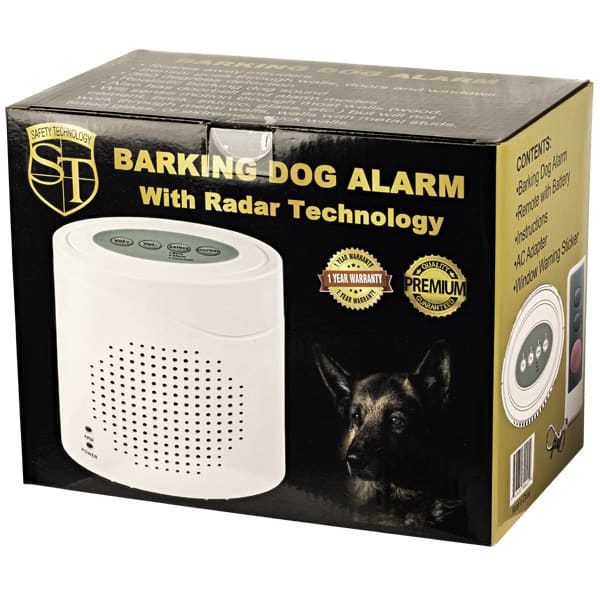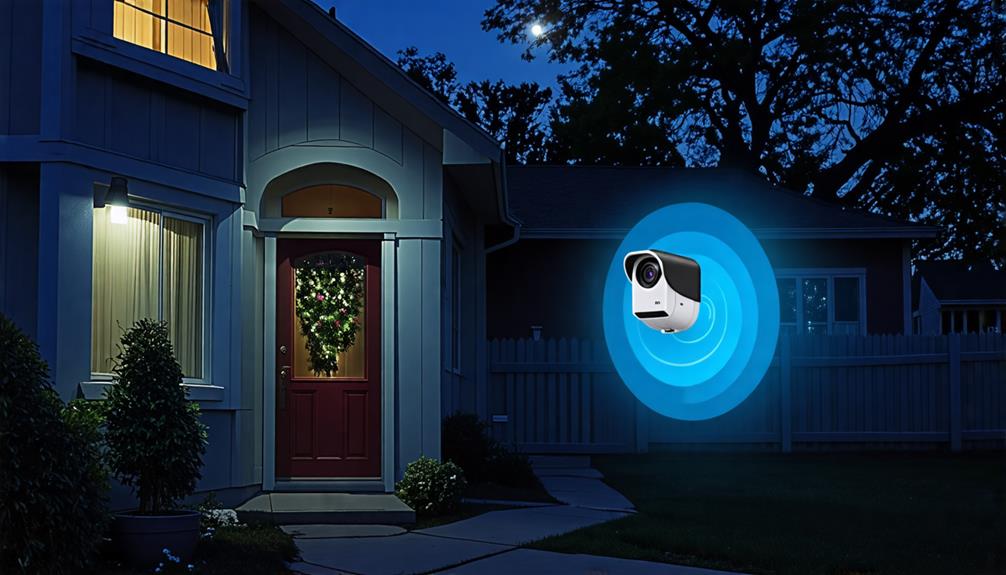
Brainstorm Security Shop

For Orders Over $199

On Any Of Our Products

Details On Refund Page
Have you ever considered enhancing your home security with a Barking Dog Alarm that comes equipped with night vision? This device uses infrared technology to detect movement in low light, while simulating the protective presence of a vigilant guard dog. You may find it intriguing how it combines sound and visual monitoring to deter potential intruders without the need for constant upkeep. As effective as it sounds, you might wonder about its reliability and whether it can truly replace or supplement traditional security systems. Let’s explore how this technology stands up to real-world security challenges.
Barking dog alarms are electronic devices designed to mimic the sound of a dog barking when triggered by motion or activity. These alarms use sensors to detect when someone is approaching your property, setting off a realistic barking sound. It’s like having a virtual watchdog without the need for an actual pet.
You might wonder if these alarms really work. Their effectiveness often depends on the realism of the barking behavior they replicate. Manufacturers have fine-tuned the audio to sound incredibly authentic, which can deter trespassers effectively. The psychological impact of hearing a fierce dog can be enough to make intruders think twice before proceeding.
However, it’s not just about scary sounds. The timing and variation in barking play a crucial role in maintaining the illusion of a real dog. A constant, monotonous bark might soon be recognized as a loop, reducing the alarm’s effectiveness.
Therefore, the best devices offer varied barking patterns that escalate as the threat gets closer, enhancing the alarm’s believability and security impact.

Key features of these alarms enhance their effectiveness in deterring unwanted visitors from your property. Understanding the core components will help you select the best system for your needs and ensure maximum security.
Here’s a breakdown of what sets these alarms apart:
These features combined create a reliable and effective security solution.
You’ll appreciate the peace of mind that comes from knowing your property is well-protected.
Harnessing the power of modern technology, night vision allows you to see in the dark as clearly as during the day. This remarkable capability is primarily due to two advanced techniques: infrared technology and image enhancement.
Let’s dive into how these technologies empower you to monitor your surroundings, even in total darkness.
Infrared technology functions by detecting heat emitted by objects. Every object, whether animate or inanimate, emits some level of infrared light due to its temperature. The night vision feature in your barking dog alarm uses this technology to capture this invisible infrared light and convert it into a visible image.
This allows you to see a clear picture of what’s happening outside your home, without any visible light.
Image enhancement, on the other hand, takes the available bits of light in a dark environment—whether it’s starlight or just faint moonlight—and amplifies them to create a more detailed and enhanced image.
This process significantly boosts the quality of the visuals, making it easier for you to identify potential threats or disturbances around your property.
Together, these technologies ensure that your barking dog alarm isn’t just an auditory deterrent but a vigilant visual guardian as well.
Now that you’re familiar with how the night vision feature works in your barking dog alarm, it’s time to get it set up.
First, you’ll need to decide where to install the device to ensure optimal performance.
We’ll cover what tools you’ll need and walk you through the installation process step by step.
Selecting the right location for your barking dog alarm is crucial to its effectiveness.
You’ll want to consider both the outdoor environment and potential installation challenges to ensure optimal performance.
Here’s what you need to keep in mind:
Before you begin installing your barking dog alarm, it’s essential to gather all the necessary tools to ensure a smooth and efficient setup. This system, packed with barking detection technology and night vision advancements, requires specific tools for proper installation.
Firstly, you’ll need a high-quality drill and a set of drill bits. The size and type of bits depend on the mounting surface, but typically, a 1/4-inch bit is a good start. You’ll also need screws and wall anchors suitable for your wall type—whether it’s drywall, brick, or wood.
A screwdriver, preferably electric to save you time and effort, is crucial. Include both Phillips and flathead attachments to match various screw types that may come with the device.
Next, ensure you have a wire stripper and electrical tape on hand, as you might need to make some adjustments to the wires, especially if your model includes features like enhanced night vision capabilities.
Lastly, don’t forget a level and a measuring tape. Precision is key to ensuring your barking dog alarm is set up at the optimal height and angle for maximum coverage and efficiency.
With these tools ready, you’re set to move on to the installation itself.
With your tools in hand, you’re ready to install the barking dog alarm. This device not only enhances your home security with its barking detection but also includes night vision to keep an eye on things even in low light.
Here’s a straightforward guide to get you started:

Once you’ve followed these steps, you’ll have an extra layer of security that keeps you informed and prepared, day or night.
When setting up your barking dog alarm, it’s crucial to consider where you place it.
Make sure it’s visible in strategic areas to deter intruders effectively, and think about the height and angle to maximize its detection range.
These placement strategies ensure your alarm works efficiently in securing your home.
Identifying strategic visibility areas for your barking dog alarm maximizes its effectiveness in deterring intruders.
By carefully choosing where to place your alarm, you’ll ensure it not only detects but also frightens off any unwanted visitors effectively.
Let’s dive into some key spots around your home where strategic lighting and visibility enhancement can play a pivotal role.
Here are five prime locations to consider:

To maximize the effectiveness of your barking dog alarm, it’s crucial to consider both the height and angle at which the device is mounted. Proper height adjustment ensures that the alarm’s sensors are optimally positioned to detect movement without obstruction. Typically, mounting the alarm at about 2 to 3 meters above ground level strikes a balance between too low, where pets or small children might trigger it, and too high, which might miss important activities at ground level.
Angle optimization is equally important. You’ll want to angle the device so that it covers the intended area effectively. This means directing it slightly downwards, focusing on entry points or paths leading to your home. Avoid positioning it directly against the sun or bright lights, which could cause glare and impair the sensor’s ability to detect accurately.
Experiment with different settings during installation. Observe how the alarm reacts to different movements at various times of the day. Adjustments might be necessary as you fine-tune its positioning to ensure that it provides the best coverage and triggers accurately and reliably.
Many barking dog alarms now incorporate dual technology to enhance security and reliability. You’ll find that this dual detection approach offers significant advantages, providing enhanced security features that keep your home safer.
By combining multiple detection methods, these alarms minimize false triggers and improve the accuracy of real threat detection.
Here’s how you benefit from this innovative technology:
As you can see, integrating dual technology into your barking dog alarm isn’t just about keeping up with trends; it’s about making a smarter choice for your home’s security.
Choose a system that utilizes these capabilities to truly protect what matters most to you.
Comparing security systems can feel overwhelming, but it’s crucial for finding the right fit for your home. You’ve got to consider several factors, like how well a system integrates with your existing smart home setup.

Smart home integration allows your security system to seamlessly connect with other devices, enhancing overall functionality and control. Can you imagine adjusting your security settings just by speaking to your virtual assistant? That’s the convenience you’re looking at!
Next, let’s talk cost comparison. It’s vital to weigh both the initial investment and the ongoing costs. Some systems might seem cheaper upfront but could have higher maintenance or subscription fees.
You’ll want to look at what each package includes. Does it cover all areas of your home? Is video surveillance with night vision included, or will that be extra? Remember, sometimes you do get what you pay for.
Lastly, consider the usability and support offered. A system that’s complex to operate mightn’t be the best choice if you’re not tech-savvy.
Customer support availability can also be a dealbreaker. You’ll want someone on the other end to help if things go sideways. Choose wisely, as the right system can bring peace of mind and enhanced security to your home.
After selecting the perfect security system for your home, maintaining it properly ensures it continues to function effectively and protect your space. Regular upkeep isn’t just about fixing things when they break; it’s about preventing issues before they start and ensuring optimal performance.
Here are some key maintenance tips to keep your barking dog alarm system in top shape:
Don’t forget about weatherproofing advice and looking into replacement parts when needed.
Regular performance monitoring can alert you to potential issues before they become serious problems. Keep your system running smoothly with these straightforward steps.
If you’re frequently dealing with false alarms from your Barking Dog Alarm, it’s crucial to identify and resolve the triggers.
Enhancing the image clarity can also play a significant role in improving the alarm’s accuracy.
Let’s explore how you can adjust the settings to better meet your security needs.

Many users experience false alarms with their barking dog alarms, which can be both annoying and disruptive. Understanding the common causes and how to adjust your settings is crucial for reducing these incidents.
The problem often lies in the alarm’s sensitivity and the specific barking triggers it detects. Here are some practical steps you can take:
Improving image clarity in your barking dog alarm system can significantly enhance its effectiveness. If you’ve been struggling with grainy or blurred images, especially during nighttime, it’s time to dive into the world of image processing and contrast adjustments.
Firstly, check your system’s settings. Most modern alarms come with adjustable parameters for image processing. You’ll want to increase the contrast to help distinguish features in the dark better. Don’t be afraid to experiment with these settings until you find the perfect balance for clear images.
Sometimes, environmental factors like fog or rain can obscure your vision. In these cases, enhancing contrast can cut through the clutter and improve your system’s accuracy. If tweaking the contrast isn’t enough, consider upgrading your camera’s lens or adding additional lighting around the areas where your alarm is most frequently triggered.
Lastly, keep your camera lens clean. Dust and smudges can drastically reduce image quality, making even the best settings ineffective. Regularly wipe down the lens with a soft, dry cloth.
Reviewing customer feedback, you’ll find that the Barking Dog Alarm generally receives high marks for its effectiveness and ease of use. Many users highlight how the product reliability stands out, ensuring peace of mind when it comes to home security.
The integration of night vision technology has been a game-changer, according to several reviews.
Here’s what people are saying:
These testimonials reflect typical customer experiences, emphasizing how the Barking Dog Alarm doesn’t just perform well but also delivers reliability and user satisfaction.
You’ll be hard-pressed to find a more versatile and dependable security solution that offers such an innovative blend of features.

You’re probably wondering if the device can tell the difference between humans and animals moving around.
Unfortunately, it’s not that advanced. It uses basic motion detection technology, which means you’ll likely experience some false alerts now and then.
So, if a cat scurries by or a bird flies close, the alarm might sound just as it would for a person.
It’s good for general awareness but not perfect in distinguishing types of movement.
You’re considering the device’s durability, especially for outdoor installation, right?
It’s essential to know whether it’s weatherproof. The good news is, yes, it can handle various weather conditions, making it suitable for outdoor use.
You won’t need to worry about rain, snow, or extreme temperatures affecting its performance. This ensures reliable operation year-round, keeping your home safe regardless of the season.
Make sure you follow the manufacturer’s guidelines to maximize its lifespan.
You’re wondering if your alarm requires Wi-Fi to function. No, it doesn’t need Wi-Fi connectivity to operate effectively.
This feature ensures that your wireless security system remains active even without internet access, enhancing reliability especially in remote areas.
Additionally, it includes pet detection technology, which helps minimize false alarms triggered by small animals.
This makes it a dependable choice for keeping your property secure without the constant need for internet connectivity.
You’re wondering about potential subscription fees for cloud storage options.
Typically, many devices offer initial free cloud storage, but for extended storage capacity and enhanced data security features, you might face monthly or annual fees.
It’s crucial to check the specific terms provided by the manufacturer or service to understand what you’ll need to pay to keep your data accessible and secure over time.
Yes, you can integrate it with your existing smart home systems.
It’s designed with smart home compatibility in mind, offering various integration options to seamlessly connect with platforms like Google Home or Amazon Alexa.
This allows you to manage all your devices from one central location, enhancing both convenience and security.
You’ll appreciate how easily it fits into your smart home ecosystem, enabling more efficient control and monitoring.
You’ve explored the innovative Barking Dog Alarm with Night Vision, understanding its key features and how night vision enhances security. With the installation guide and optimal placement strategies, you’re set to safeguard your home effectively. Remember, maintaining your system is crucial for longevity, and troubleshooting tips will keep it running smoothly. Considering user reviews, you’re now equipped to make an informed decision. Compare it with other systems to ensure you choose the best protection for your space.

Brainstorm Security Shop
1867 Caravan Trail
Ste 105
Jacksonville, FL 32216
Call us toll free: (800) 859-5566